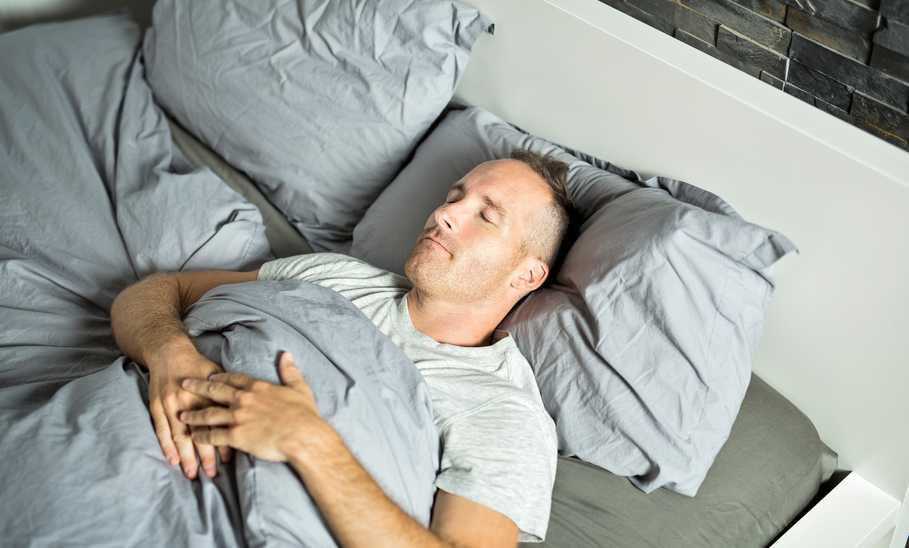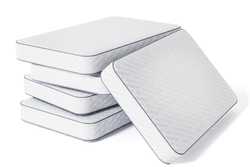How to Sleep on Your Back: A Guide to a More Comfortable Night’s Rest

Our evaluations and opinions are not influenced by our advertising relationships, but we may earn a commission from our partners’ links. This content is created by TIME Stamped, under TIME’s direction and produced in accordance with TIME’s editorial guidelines and overseen by TIME’s editorial staff. Learn more about it.
People change positions around 11-13 times per night, influenced by temperature, noise, mattress comfort, and bed partner movement, according to the Better Sleep Council (BSC). Most people sleep in one position, depending on how they feel most comfortable in bed, but sometimes your sleep position changes due to a life event. A few years ago, I had a frozen shoulder, which meant I couldn’t sleep on my side—my preferred method of sleeping. I had to teach myself how to sleep on my back to avoid jostling my joints and setting off tremendous pain. Over time, I figured out how to lie flat at night, usually with rolled-up blankets under my knees, to help me stay in a position that wasn’t painful. It would have been handy to learn ahead of time how to sleep on your back before my shoulder issue. It turns out sleeping on your back can be beneficial for many reasons. So I jumped at the opportunity to write about how to sleep on your back to find out why this position may be a good option.
“Good sleepers change positions less,” says Mary Helen Rogers from the Better Sleep Council. “Sleep position preferences can develop as early as age seven, with waking positions usually reflecting preferences, and some people have multiple preferred positions.”
She explains that changing natural sleep positions might disrupt sleep quality, but certain conditions may necessitate changes. Strategic pillow use, body pillows, or adjustable bases can help if you need to change positions. Sleep positioning is important because quality sleep is important to quality of life and health.
“Your sleeping position can have an impact on several factors, such as your sleep quality and comfort, and may have an effect on certain health issues,” reports Dr. Chelsie Rohrscheib, Ph.D., Rohrscheib, a sleep expert and currently the head of sleep at Wesper, a sleep disorder diagnostics company. “For instance, individuals with chronic back or joint pain typically find the most comfort sleeping on their back with their spine well-aligned and well-supported.”
People with certain health conditions such as sleep apnea or gastric reflux disease (GERD) are typically recommended to sleep on their side, says Rohrscheib. In addition, side sleeping is good for pregnant people (sleeping on the left side) and people with back pain who use pillows between their knees, according to The Better Sleep Council data. Our guide to the best mattresses for side sleepers and the best pillows for side sleepers can help maximize your comfort, too.
If you sleep on your stomach, you may want to rethink your position, although only 17% of people sleep this way. This is according to data from BSC, who report stomach sleeping is not recommended by sleep professionals because it can cause neck aches and strains, as well as lower back issues for some people.
Back sleeping can be a good idea if you do it carefully. If you suffer from lower back pain or apnea, this may not be the best position for you. But you can make back sleeping more comfortable using a rolled-up towel, blanket, or bolster pillow under your knees, which will help you sleep following the natural curve of your spine. The best pillows for back sleepers and the best mattresses for back pain can provide the support you need.
![[object Object] [object Object]](https://i5.walmartimages.com/seo/Beckham-Hotel-Collection-Luxury-Linens-Down-Alternative-Pillows-for-Sleeping-Queen-2-Pack_66ebcf33-bd46-426d-b34d-21cadf357ae4.a9e783725cc4f1641b1b561b7f831a57.jpeg?odnHeight=640&odnWidth=640&odnBg=FFFFFF)
According to sleep experts, sleeping on your back may have several benefits, such as better spine alignment, fewer tension headaches, and less neck pain.
Dr. Rohrscheib explains that sleeping on your back may reduce the symptoms of acid reflux disease (GERD) when you sleep with your head elevated. “When you sleep on your back, it makes it more difficult for stomach acid to flow back into the esophagus.”
Some experts say that back sleeping may reduce facial wrinkles and puffiness that can occur in other positions. “This is because it keeps pressure away from your facial structures,” says Dr. Rohrscheib.
“Back sleep prevents joint pain, especially in the shoulders, knees, and hips, that may occur when sleeping on your side,” Dr. Rohrscheib explains. “It can also prevent your limbs from falling asleep, which is an uncomfortable experience.”
When you sleep on your back, you may prevent too much curvature of the spine during sleep and distribute pressure across your body evenly, says Rohrscheib. “This may reduce pain and lowers the risk for further back problems.”
Sleeping on your back with your head slightly elevated may help reduce or relieve sinus buildup, especially if you keep your head slightly elevated with a medium loft pillow or pillows. This positioning may allow your sinuses to drain which is harder to do, if, say, you’re sleeping on your stomach.
Many back sleepers find it most comfortable to tuck a pillow under their knees and slightly elevate their head, using a medium-firm mattress and pillow. Lying completely flat on a firmer surface may be more comfortable than a softer one you sink into, but back sleepers will likely have their own preferences.
“Usually, I recommend a medium-firm memory foam pillow because it is strong enough to keep your spine and head in alignment while offering plenty of comfort,” says Dr. Rohrscheib. “Your pillow should not be too hard or too soft, too high or too low. Aim for your head and neck to be closely aligned with the rest of your body.”
The goal is a mattress that stays in contact with your body, yielding just enough, recommends Rogers. “If it presses back against your hip or shoulder, you’ll need to shift, interrupting your sleep. That’s why side and stomach sleepers need softer beds. Heavier people, and those who sleep on their backs, need more support.” A firmer mattress will likely benefit back sleepers, although both experts point out that bedding is usually a personal preference.
![[object Object] [object Object]](https://m.media-amazon.com/images/I/61tEJAJfnNL.*AC_SL1500*.jpg)
Back sleeping is the second most common sleep position, but for optimal comfort, Rogers and other sleep expats recommend placing a soft pillow or rolled-up towel under your knees to facilitate the natural curve of the spine. “Back sleeping is generally not recommended for people with sleep apnea and during the later months of pregnancy,” says Rogers. In those cases, side sleeping with pillows may be a better choice depending on your condition.
Certain health conditions, such as sleep apnea, gastric reflux disease, and pregnancy, may make back sleep less than ideal. These individuals should prioritize sleeping on their left sides. A good medium-to-firm memory foam mattress will allow side sleepers to sleep comfortably on their sides and reduce the risk of too much pressure on the shoulders, knees, and hips.
The best pillows for back sleepers are, generally speaking, medium-loft, somewhere between three and five inches, for comfort. Of course, everyone’s sleep preferences are different, so make sure to try out different pillows to find the best one. When you sleep on your back, slightly elevated may feel better than lying flat.
As our sleep experts mentioned, a medium-firm mattress may be the best option for rest. Many kinds of mattresses are available for back pain, and a medium-firm memory foam one may be a good option, according to Rohrscheib. Our guide to the best firm mattresses can also be a good resource for finding the right level for your needs.
Back sleepers may benefit from using bolster pillows under the knees. “For those who prefer to sleep on your back, a word of warning: This can induce lower back pain and even episodes of apnea, which interfere with normal sleep and restfulness,” cautions Rogers. “However, a few minor alterations to this position can have you sleeping soundly. Try placing a soft pillow or rolled-up towel under your knees to facilitate the natural curve of the spine.”
If you want to try sleeping on your back, especially for a medical reason, it’s always best to speak to a physical therapist or doctor about bedding and even sleep position recommendations.
The information presented here is created by TIME Stamped and overseen by TIME editorial staff. To learn more, see our About Us page.



